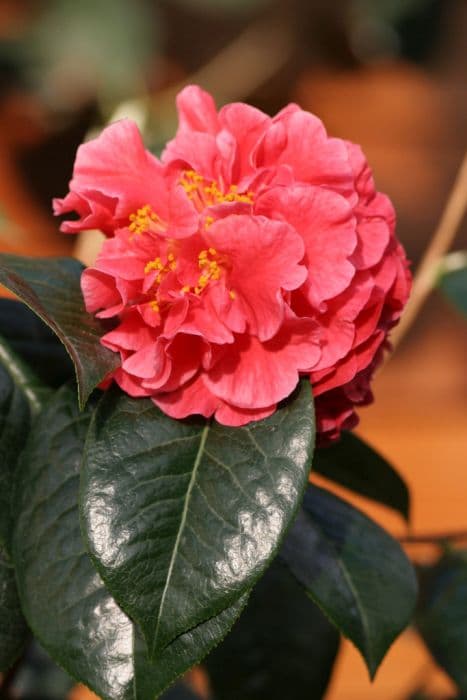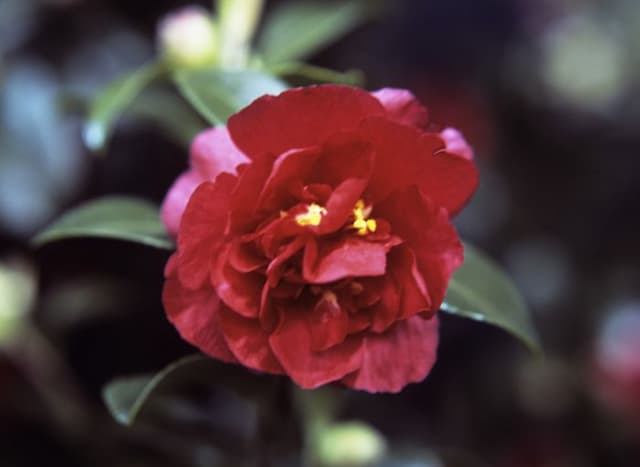Leonard Messel Camellia Camellia 'Leonard Messel' (reticulata × (× williamsii))

ABOUT
The Camellia 'Leonard Messel' is an enchanting flowering shrub, distinguished by its showy blossoms and lush, glossy foliage. The plant produces magnificent flowers that are a visual delight. Each flower boasts an array of pink petals that exhibit a subtle gradation of shades, creating a captivating spectacle as they unfurl. Some blooms may have a deeper pink at the edges, fading to a softer hue as the eye moves toward the center. Often, the petals display a ruffled or delicately scalloped edge, adding to the luxurious texture and overall appeal of the bloom. At the heart of the flower, a cluster of bright stamens often peaks out, contrasting with the pink petals and attracting pollinators. The flowers emerge during the late winter to early spring seasons, signaling the end of cold days and bringing with them the promise of renewal. Complementing the striking flowers are the plant's leaves, which are a deep, glossy green. They offer a year-round appeal with their dense and lush appearance, providing a perfect backdrop that makes the pink flowers stand out even more. Overall, Camellia 'Leonard Messel' is a plant that is highly regarded for its decorative flowers and foliage, capable of bringing a touch of elegance and vibrant color to any garden landscape.
About this plant
 Names
NamesFamily
Theaceae
Synonyms
Leonard Messel Camellia
Common names
Camellia 'Leonard Messel' (reticulata × (× williamsii))
 Toxicity
ToxicityTo humans
The Camellia 'Leonard Messel', commonly referred to as Leonard Messel camellia, is generally considered non-toxic to humans. There are no well-documented cases of poisoning from this plant, so ingesting it is unlikely to cause any adverse health consequences.
To pets
Like for humans, the Leonard Messel camellia is also considered non-toxic to pets. While it is always best to prevent pets from eating plants as a precaution, ingestion of this specific camellia variety is not expected to cause poisoning or serious health issues in pets.
 Characteristics
CharacteristicsLife cycle
Perennials
Foliage type
Evergreen
Color of leaves
Dark green
Flower color
Pink
Height
10-15 feet (3-4.5 meters)
Spread
6-10 feet (1.8-3 meters)
Plant type
Shrub
Hardiness zones
7
Native area
China
Benefits
 General Benefits
General Benefits- Aesthetic Appeal: The Camellia 'Leonard Messel' produces large, showy flowers that are a visual draw in any garden or landscape setting.
- Long Blooming Season: It typically has a long flowering period which provides color and interest over several months.
- Versatility in Landscaping: It can be used for various purposes in landscaping including hedging, specimen planting, and as part of mixed borders.
- Evergreen Foliage: Its evergreen leaves offer year-round color and texture for gardens, providing a stable backdrop for seasonal plantings.
- Drought Tolerance: Once established, it has a degree of drought resistance, making it suitable for gardens with drier conditions.
- Wildlife Attraction: The flowers can attract pollinators such as bees, adding to the biodiversity of the garden environment.
- Cold Tolerance: This variety has a good tolerance to cooler temperatures, making it suitable for a range of climates.
 Medical Properties
Medical PropertiesThis plant is not used for medical purposes.
 Air-purifying Qualities
Air-purifying QualitiesThis plant is not specifically known for air purifying qualities.
 Other Uses
Other Uses- Culinary Garnish: The flowers of Camellia 'Leonard Messel' can be used as an attractive, non-toxic garnish for salads and desserts.
- Textile Dye: The petals can be used to create natural dyes for fabrics, yielding delicate shades of pink and red.
- Photography: The plant provides a vivid and attractive background for photographers interested in capturing the beauty of blooms.
- Craft Projects: Dried Camellia petals can be incorporated into paper making or used for potpourri and craft decorations.
- Religious Ceremonies: In some cultures, Camellia flowers are used as offerings or decorations in various religious services.
- Feng Shui: The plant is used in the practice of feng shui to attract positive energy when placed properly around the home.
- Cosmetic Uses: The petals can be infused in oils and used in homemade cosmetics or bath products for natural fragrance and color.
- Educational Material: Camellia 'Leonard Messel' can be used in botany classes for studying hybridization and flower structure.
- Floral Arrangements: The stems and blooms are incorporated into floral displays for events, adding elegance and a touch of spring.
- Artistic Inspiration: Artists may use Camellia 'Leonard Messel' as a subject in paintings, drawings, and other artistic endeavors.
Interesting Facts
 Feng Shui
Feng ShuiThe Camellia is not used in Feng Shui practice.
 Zodiac Sign Compitability
Zodiac Sign CompitabilityThe Camellia is not used in astrology practice.
 Plant Symbolism
Plant Symbolism- Admiration: The Camellia is often associated with deep admiration, reflecting the beauty and impressive form of its blooms.
- Perfection: With its flawless petals, the Camellia represents the ideal of perfection and excellence.
- Longevity: The Camellia's ability to flower through the chill of late winter and early spring suggests enduring strength and longevity.
- Love: Various colors of Camellia blooms symbolize different aspects of love. A red Camellia, for example, symbolizes deep romantic love.
- Affection: Giving a Camellia flower can express genuine affection and emotional warmth towards someone.
 Water
WaterCamellia 'Leonard Messel' requires consistent moisture and should be watered when the top inch of soil feels dry. In general, watering once a week with 1 to 1.5 gallons of water should suffice, but this frequency may need to increase during hot, dry weather or if the plant is in a container. It is best to water deeply and thoroughly, allowing the water to penetrate the root zone. Avoid overhead watering to prevent disease, and instead use a soaker hose or water at the base of the plant. Reduce watering during the winter months when the plant is not actively growing.
 Light
LightCamellia 'Leonard Messel' thrives in partial shade to dappled sunlight. It prefers a spot that is protected from the harsh afternoon sun but receives bright, indirect light for the majority of the day. An ideal location would be under the canopy of tall trees that provide filtered light or on the north or east side of a building where it can enjoy morning light without being exposed to intense afternoon rays.
 Temperature
TemperatureCamellia 'Leonard Messel' is best suited for temperate regions with temperatures ranging from 40 to 85 degrees Fahrenheit. The plant can survive minimal dips below 40 degrees but should be protected from frost and freezing temperatures. During hot spells, ensure adequate mulching and watering to help maintain cooler root temperatures. Ideal growing conditions would include moderate, stable temperatures without extreme fluctuations.
 Pruning
PruningCamellia 'Leonard Messel' should be pruned for shaping, removing dead or weak branches, and promoting healthy growth. The best time to prune is just after the blooming season in late winter or early spring since camellias set their flower buds for the next year shortly after blooming. Light pruning each year will help maintain the desired shape and encourage vigorous growth, but extensive pruning should be done sparingly and only when necessary.
 Cleaning
CleaningAs needed
 Soil
SoilCamellias require acidic soil with a pH of 5.5 to 6.5 that is well-draining, rich in organic matter. A mix containing 2 parts peat moss, 1 part perlite, and 1 part pine bark is ideal for proper growth and bloom.
 Repotting
RepottingLeonard Messel camellias should be repotted every 2-3 years or when they outgrow their current pot, preferably in the spring after flowering has finished.
 Humidity & Misting
Humidity & MistingLeonard Messel camellias thrive best in moderate to high humidity levels, ideally between 40-60%, to mimic their natural humid woodland habitats.
 Suitable locations
Suitable locationsIndoor
Provide bright, indirect light and keep soil moist.
Outdoor
Plant in partial shade, shelter from strong winds, keep soil moist.
Hardiness zone
7-9 USDA
 Life cycle
Life cycleThe Leonard Messel camellia begins its life as a seed, which germinates in a warm, moist environment, developing a radicle that grows into a root system and a shoot that emerges from the soil. The seedling gradually matures into a young plant with a set of true leaves, utilizing photosynthesis for growth. Over several years, the juvenile plant advances to a mature shrub, characterized by glossy, evergreen leaves and woody stems. The Leonard Messel camellia reaches reproductive maturity and begins its flowering stage, typically from late winter to spring, producing showy, fragrant pink flowers that attract pollinators. After pollination, the plant develops seed pods, which eventually dry and release seeds, continuing the reproductive cycle. Throughout its life, the camellia may undergo periods of dormancy during colder months, only to resume active growth with the return of warmer, favorable conditions.
 Propogation
PropogationPropogation time
Spring-Early Summer
Propogation: Camellia 'Leonard Messel', a hybrid camellia, is commonly propagated through semi-hardwood cuttings. This method is most effectively carried out in late summer after the new growth has begun to mature and harden slightly. Cuttings of about 4 to 6 inches in length with several leaves are taken and the lower one-third to one-half of the leaves are removed. The cut end is then dipped in a rooting hormone to encourage root development. The treated cutting is inserted into a well-draining potting medium, such as a mix of peat and perlite. It's important to maintain high humidity around the cuttings, often achieved by placing a plastic cover over the pots. Cuttings typically root within 6 to 12 weeks, after which they can be gradually acclimated to less humid conditions and eventually potted on as individual plants.









